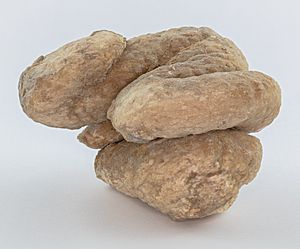Coprolite facts for kids
A coprolite is fossilized animal waste, like ancient poop! These amazing fossils are not parts of an animal's body, but they are a type of trace fossil. Trace fossils show us what an animal did, rather than what it looked like. Coprolites are super helpful because they can tell us about an animal's diet and how it lived millions of years ago.
The word "coprolite" comes from two Greek words: kopros, which means "dung" (another word for poop), and lithos, which means "stone". So, it literally means "dung stone"! The first person to describe coprolites was a scientist named William Buckland in 1829.
Contents
What is a Trace Fossil?
A trace fossil is evidence of an ancient animal's activity. Unlike body fossils, which are the actual remains of an animal (like bones or teeth), trace fossils show things like footprints, burrows, or even bite marks. Coprolites are special trace fossils because they are fossilized waste. They give scientists clues about what an animal ate, which helps us understand ancient food chains and ecosystems.
How Do Coprolites Form?
For animal waste to become a coprolite, it needs to be buried quickly before it decays. This usually happens in places like swamps, lakes, or riverbeds where sediment (like mud or sand) can cover it fast. Over millions of years, minerals in the surrounding sediment replace the original organic material in the waste. This process turns the soft waste into hard rock, preserving its shape and sometimes even tiny bits of what the animal ate.
What Can We Learn from Coprolites?
Scientists study coprolites to learn many things about ancient life:
- Diet: By looking closely at a coprolite, scientists can find tiny pieces of undigested food. For example, a coprolite might contain bone fragments, fish scales, plant fibers, or even pollen. This tells us if the animal was a meat-eater (carnivore), a plant-eater (herbivore), or ate both (omnivore).
- Animal Size: The size and shape of a coprolite can give clues about the size of the animal that produced it.
- Environment: The types of plants or animals found in a coprolite can help scientists understand what the environment was like millions of years ago. For instance, finding fossilized fish scales in a coprolite suggests the animal lived near water.
- Digestion: Coprolites can even show how well an animal digested its food!
Famous Coprolites
Some coprolites are very famous! One of the largest known coprolites is from a Tyrannosaurus rex. It's about 17 inches long and contains pieces of bone, showing that this giant dinosaur was indeed a fierce meat-eater. These amazing fossilized poops help us piece together the puzzle of prehistoric life.
Images for kids
-
A Miocene pseudocoprolite from Washington state. They are commonly mistaken for coprolites because of their appearance and shape; they are actually of inorganic origin. Scale in mm. See Spencer (1993).
See also
 In Spanish: Coprolito para niños
In Spanish: Coprolito para niños







